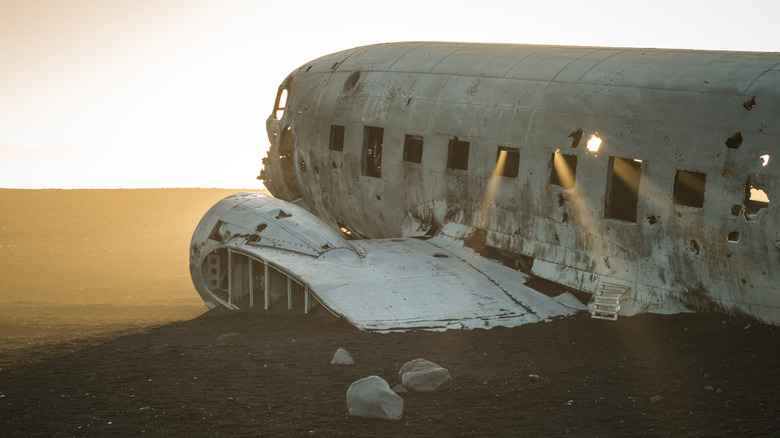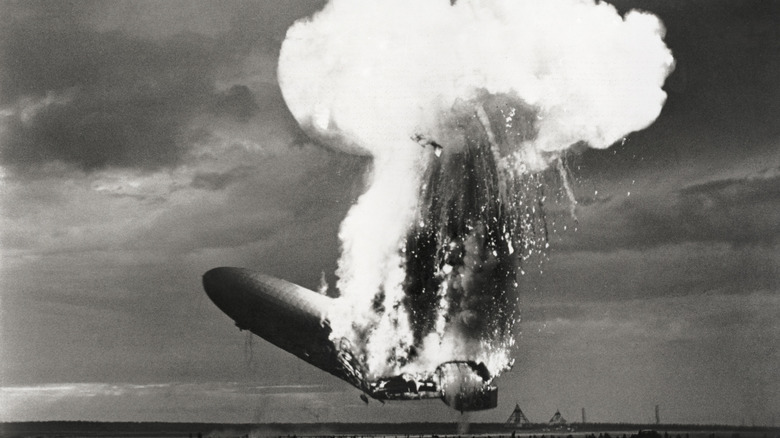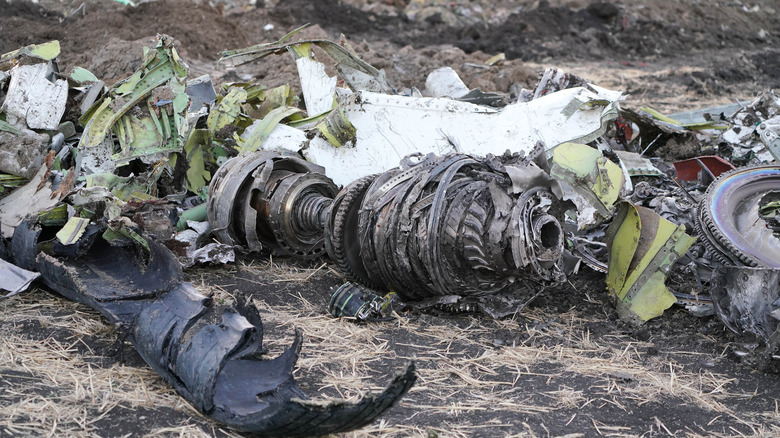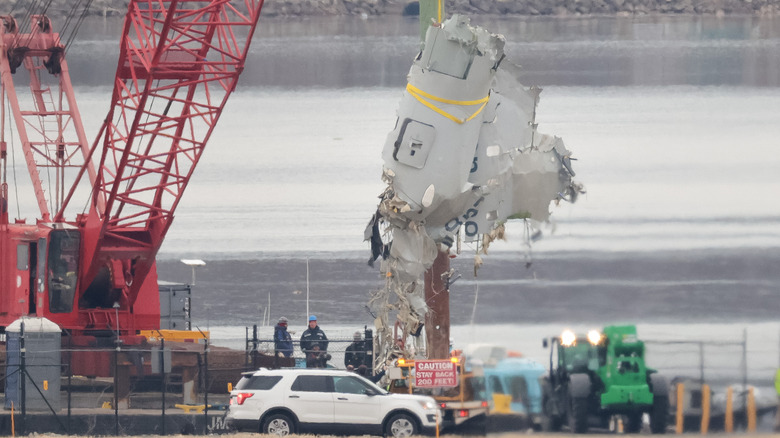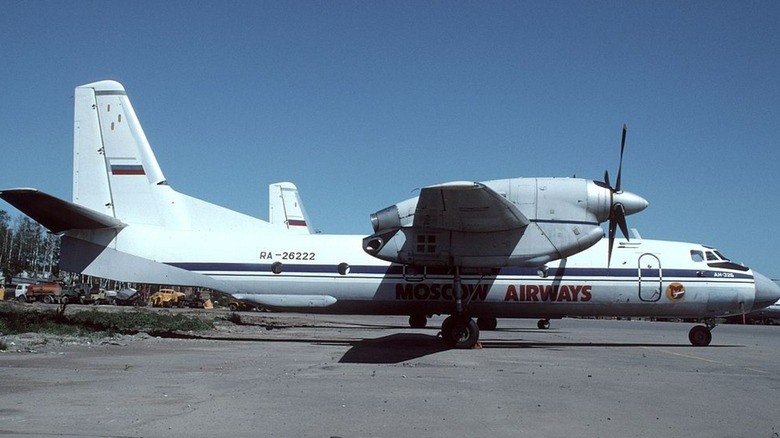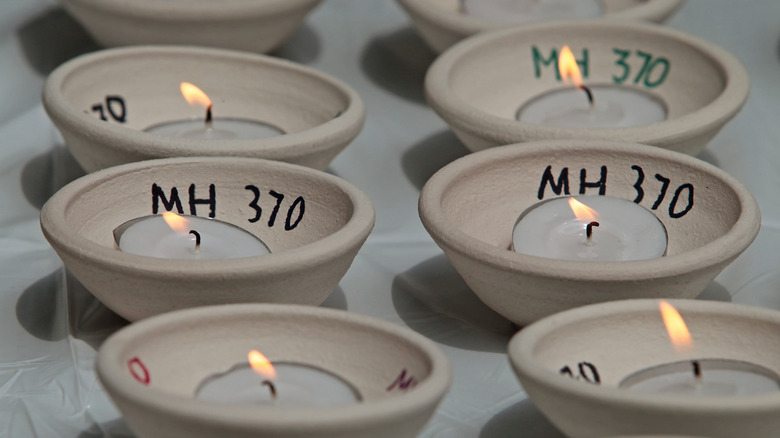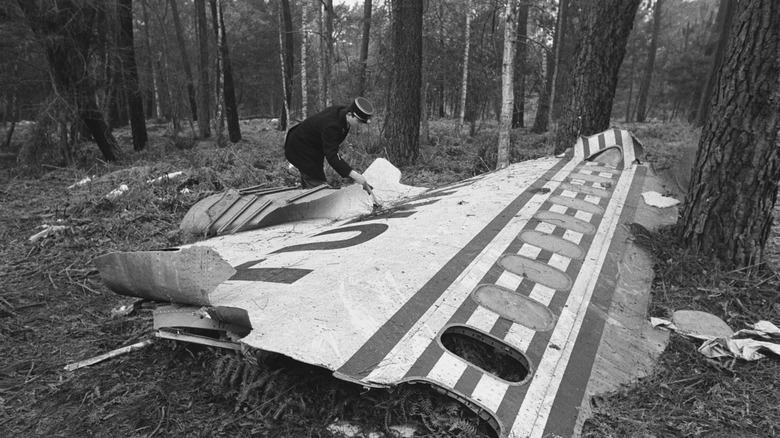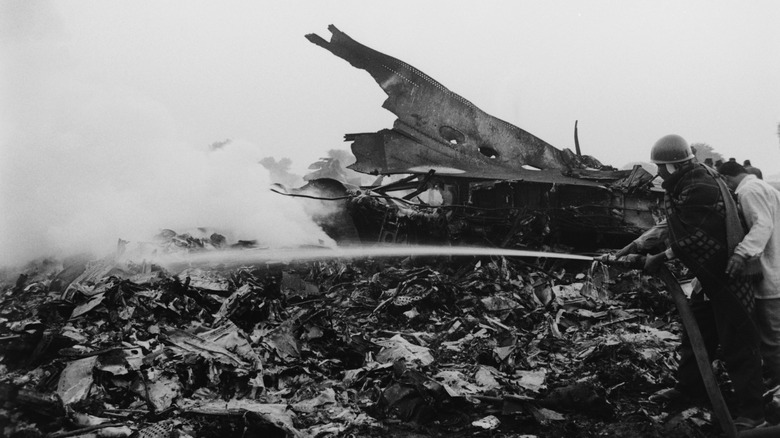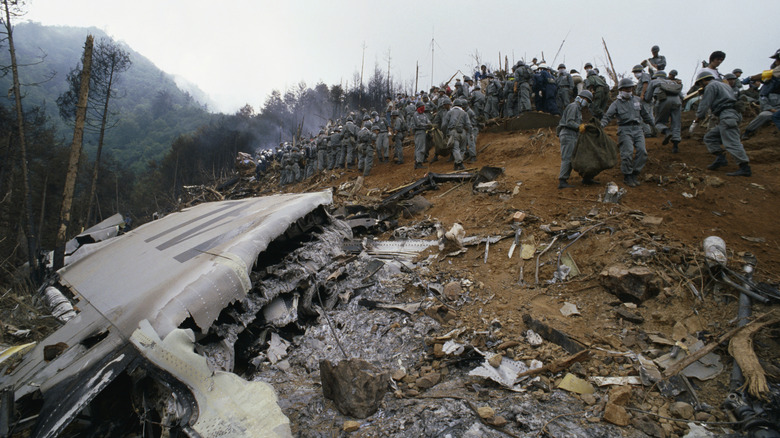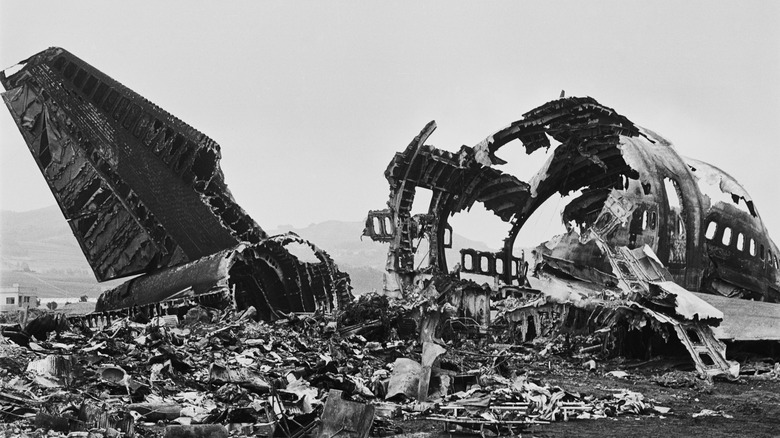10 Of Aviation History's Worst Accidents, And Why They Happened
In the century-plus since the Wright brothers lit the fuse on successful manned flight, technology and innovation have been racing toward continually increasing speed, efficiency, and safety in the air. Sadly, this hasn't been without a few missteps and tragedies. Even Orville Wright himself was significantly injured while his passenger Thomas Selfridge became the first casualty of an airplane crash in 1908.
Disaster is unfortunately an integral part of advancement in many regions of progress, and this is no different for the scientific miracle of flight, although modern aircraft are tremendously safe modes of transit. In the years since the opening of what is today the oldest continuously operating airport in the world in College Park, Maryland (a site where the Wright Brothers would train army officers to fly), plenty of crashes, accidents, and failures have taken place.
Here we are looking at 10 of the most infamous air travel incidents that have occurred, as well as the mistakes or failings behind the accident. However, these tragedies have created learning opportunities that improve the experience for everyone else. For that, humanity mourns the losses and collectively honors the victims of these and many other air travel incidents.
The 1937 Hindenburg disaster
"Oh, the humanity!" These three famous words uttered by Herbert Morrison as the Hindenburg airship caught fire and came crashing down over Lakehurst, New Jersey have become some of the most enduring in modern history. Airships were a major technological innovation for their time, and for 30 years they shuttled passengers around the world in style and with good speed. The airship was roughly twice as fast as an ocean liner of the era, and thousands of flights brought passengers where they were going without incident. However, that changed with the Hindenburg's catastrophic end.
It's scandalous and exciting to think about the disaster that radically transformed air travel in a matter of seconds as an act of sabotage, but the evidence just doesn't support that conclusion. Instead, it's become clear that the hydrogen gas that filled the airship's balloon is the source of the calamity. Designed to use helium gas, the airship instead sourced its lift with a flammable alternative because of export restrictions placed on Nazi Germany by the United States.
On this journey, a leak in the airship's gas containment balloon exposed highly flammable hydrogen to an atmosphere charged with static electricity. While grounded by its landing line, the airship exhibited a significant charge difference that led to a static discharge from its fabric outer covering. The ignition of that leaking gas ultimately killed 36 people including one on the ground and brought airship travel to a screeching halt.
Boeing 737 Max 8 crashes (and Max 9 mishaps)
In 2017, Boeing gained FAA certification for the 737 Max 8 design. Less than a year later, Lion Air Group took delivery of the company's first Max 8 aircraft. However, the airplanes were experiencing control issues and Lion Air Flight JT 610 becomes the model's first catastrophe in October 2018. Minutes after takeoff, the Max 8's sensor array initiated a dive maneuver that the flight crew couldn't fend off, leading to a crash into the Java Sea that killed all 189 people on board. In March the next year, Ethiopian Airlines Flight 302 crashed in much the same way, killing all 157 crew and passengers.
The crashes were caused in large part from a redesign of the engine. Lifting the engine higher on the wing to accommodate a bigger overall design brought a side effect into play that had to be corrected. Most importantly, the dynamics of the design tended to shift the nose upward at too steep an angle, requiring additional steps to level off the aircraft.
Rather than redesigning the plane, Boeing introduced the MCAS software to automate the stabilization. However, this new equipment wasn't mentioned in the training materials, and reports indicate that it behaved erratically from essentially the very start of its service. The Max 9 hasn't crashed like its predecessor, but it's seen critical issues of its own. Most spectacularly, an inflight door blowout on Alaska Airlines Flight 1282 in January 2024 led to the discovery of egregious production quality standards that allowed four bolts to be left off the door's build.
The January 2025 D.C. collision
The most recent disaster on this list is the January 2025 mid-air collision that took place near Ronald Reagan International Airport in D.C. The crash was the deadliest in American skies in over 20 years and involved a commercial jet and an army helicopter.
American Airlines Flight 5342 was struck by a Black Hawk helicopter engaged in training maneuvers. It's thought that the helicopter crew was wearing night vision goggles, which would have given them greater visibility facing ahead but limited their situational awareness. The helicopter crew appears to have seen the jet but received an incomplete transmission from the control tower with instructions on how to proceed in its vicinity.
The area is a hot spot for close calls and helicopters frequently occupy the skies in close proximity to commercial jets. In the aftermath of the collision which killed 67 people, new rules have been proposed to limit helicopter activity around two runways that pose a particular threat to general safety.
The 1996 Air Africa crash
The 1996 Air Africa crash is a bizarre chapter in aviation history. It's the deadliest accident in terms of ground casualty figures on record, while there were two deaths among those on board the plane.
This flight, which was slated for a journey from Kinshasa to Kahemba, was carrying cargo rather than passengers, contributing to the low fatality rate on board. However, it was the cargo that caused this disaster. The aircraft failed to complete takeoff as a direct result of a load weight exceeding the maximum take-off weight. Investigators were unable to determine the exact overage, but it's estimated that the aircraft may have been loaded with as much as seven tons of excess cargo.
Upon failure to initiate the takeoff roll, the flight crew attempted to abort the flight but acted too late and didn't have enough runway left to complete the stoppage. The plane overshot the runway and rolled until it came to rest in the Simbazikita district of Kinshasa. At least 297 people on the ground were killed in the resulting impact and fire, while another 253 people were injured.
The 1979 Mount Erebus disaster
For a short time in the late 1970s, travelers departing from Auckland could hop aboard a flight that brought them all the way back to this metropolitan hub on New Zealand's northern island. The 11-hour journey wasn't a transit route, but rather one featuring a unique sightseeing opportunity. Air New Zealand ran these flights nearly due south for two years to bring travelers down to Antarctica. Along this route, passengers would catch a glimpse of Mount Erebus on the southern continent's Ross Island, the southernmost active volcano on the planet.
The trouble for Air New Zealand Flight TE 901 came down to a change in coordinates for the flight plan. The navigation center for the airline changed two coordinates during what was thought to be a minor heading adjustment, but it ultimately charted the flight path over Ross Island rather than McMurdo Sound.
The 12,450 feet of volcanic elevation on the island proved fatal for the tour. Instead of a low pass of around 2,000 feet over the water to catch the spectacular sights of Antarctica's glacial coastline, the plane crashed into the volcano as it made its voyage across the icy frontier. All 257 people on board were killed, and the collision with this towering natural feature marks the worst civil air incident in New Zealand.
2014 Malaysia Airlines flight MH370 disappearance
Unlike the other air disasters found on this list, the Malaysian Airlines Flight MH370 incident remains unsolved. Rather than crashing and leaving behind heaps of evidence for investigators to piece together — such as the all-important black box – the aircraft simply seemed to vanish.
Almost an hour after it took off from Kuala Lumpur, the captain signed off by saying, "Good night, Malaysian three seven zero." Nothing more ever came crackling over the radio. The little evidence that has been uncovered shows the flight turning off its transponder, and radar signatures suggest that it turned back to fly back over Malaysia and then eventually toward Sumatra. One final turn to the south completes the picture that remains with investigators and the world today.
Over the next two years, search efforts scoured the Indian Ocean, and private exploration ventures also took on the task, but to no avail (although a previously undiscovered shipwreck was found). Nothing aside from a few bits of debris has ever been turned up to complete the picture and provide closure to the families of the 239 people on board. As a result, theories have run rampant as a result of this void in evidence.
Some suggest the pilot intentionally killed himself and everyone else aboard the plane, while others suggest a hijacking – potentially even a sophisticated, remote operation. There's even a theory out there that American elements were responsible for rerouting the plane to secret it away on Diego Garcia military base in the Indian Ocean. The truth, unfortunately, will continue to elude the public until tangible evidence of the plane's fate makes it into the light.
The Turkish Airlines disaster of 1974
Returning to air disasters with well-understood causes, the Turkish Airlines Disaster of 1974 is perhaps as straightforward as they come. The flight was scheduled to fly from Istanbul to Paris, after which it would perform a continuation on to bring passengers to London. The route was particularly full at the time of the accident as a result of strikes at British Airways, reducing alternatives for the itinerary.
The McDonnell Douglas DC-10 featured cargo doors that opened outward and could be closed without actually locking them back in position. The door might appear to be closed correctly, but its locking pins would not engage unless the latches were placed in the correct position. Reports indicate that instructions available on ensuring a correct closure were only in English and Turkish, and the baggage handler who closed the door before takeoff couldn't read either.
As a result, the cargo door was not properly sealed and a pressure imbalance grew as the plane gained altitude. About 10 minutes after takeoff an explosive decompression took place with the loss of the improperly secured door, and debris from the ejection downed one of the plane's engines. All 346 people on board the plane died in the resulting crash.
The 1996 Charkhi Dadri mid-air collision
The collision of two aircraft in mid-air is a grisly sight. Even with as many as 14,000 airplanes in the sky at any one time, extreme coordination and immense training help run a tight ship when it comes to managing the sky's traffic. Air crews rely on precise instructions from ground controllers in order to line up for even the simplest maneuvers in the air and on the tarmac. Misunderstandings frequently result in close calls, but those can quickly spiral into much more consequential events. The 1996 Charkhi Dadri Mid-Air Collision is an example of this.
The crash involved Kazakhstan Airlines Flight 1907 and Saudi Arabian Airlines Flight 763. As Flight 1907 was entering the air space, the pilot was cleared to start his descent. However, the incident report indicates the pilot's lack of English language knowledge as a primary culprit in the collision that would soon occur. Rather than maintaining the altitude he was instructed to descend to, the pilot continued his pitch down, coming directly into the line of oncoming traffic and colliding with another aircraft.
The incident report suggests that the controller clearly stated, "Maintain 150" — meaning 15,000 feet — and warned the pilot about the Saudi flight ahead. It's possible that the next words: "Fourteen miles now, roger 1907," and "Traffic in 13 miles, level 140" could have been picked up as an instruction to reduce altitude to 14,000 feet by a weak English speaking listener. Either way, the planes collided and killed everyone on board, resulting in 349 fatalities and India worst ever aviation disaster.
The 1985 Japan Airlines crash
The deadliest crash involving a single aircraft took place during a takeoff from the Tokyo-Haneda Airport. The takeoff went according to plan, but a few minutes into the climb a rupture in the tail segment of the plane depressurized the aircraft. The subsequent loss of the plane's tailcone and the vertical fin rendered many of its controls inoperable and the aircraft collided with the Osutaka Ridge. 520 people were killed in the crash, although there were, incredibly, four survivors.
The incident that eventually doomed this aircraft actually took place nearly a decade earlier. In 1978, the tail of Boeing 747SR-46 struck the runway on its second touchdown during a landing maneuver in Osaka. Significant damage was sustained, and intensive repairs were made to the aircraft.
However, the efforts to return JA7119 to operation failed to fully repair the fuselage, and over the years fatigue cracks began to form in the aft section of the plane. Maintenance inspections never turned up these cracks, and this issue was given the space it needed to grow into a catastrophic point of failure.
The 1977 Tenerife Airport disaster
The Tenerife Airport Disaster took place in 1977 and earns the grim honor of being the deadliest air travel accident ever. The stress factors that led to this collision started just a short island hop away at the Las Palmas Airport on nearby Gran Canaria. A bomb exploded early in the afternoon there, and flights were diverted to Tenerife in the face of a potential second bomb. A congested tarmac resulted in strained communications between the tower and airplanes waiting for instructions at Tenerife.
In the heat of confusion, Pan Am Flight 1736 and KLM Flight KL4805 both engaged their radios at the same time, creating feedback in the KLM flight crew's cockpit. This obscured the reality that the Pan Am flight was still on the runway that the KLM flight was about to use to initiate a takeoff maneuver.
The KLM crew saw the Pan Am plane moments before impact and began to nose up, attempting to climb over the runway impediment. Sadly, it was too late. The two aircraft collided, with the Pan Am plane getting sheared in half and the KLM flight reaching the air briefly before coming back to ground around 150 meters away and engulfed in flames as it slid to a halt. All 248 occupants of the KLM aircraft were killed in the impact and resulting fireball, and 335 of the 396 total passengers and crew members of the Pan Am flight succumbed to the incident, resulting in a total of 583 casualties.
